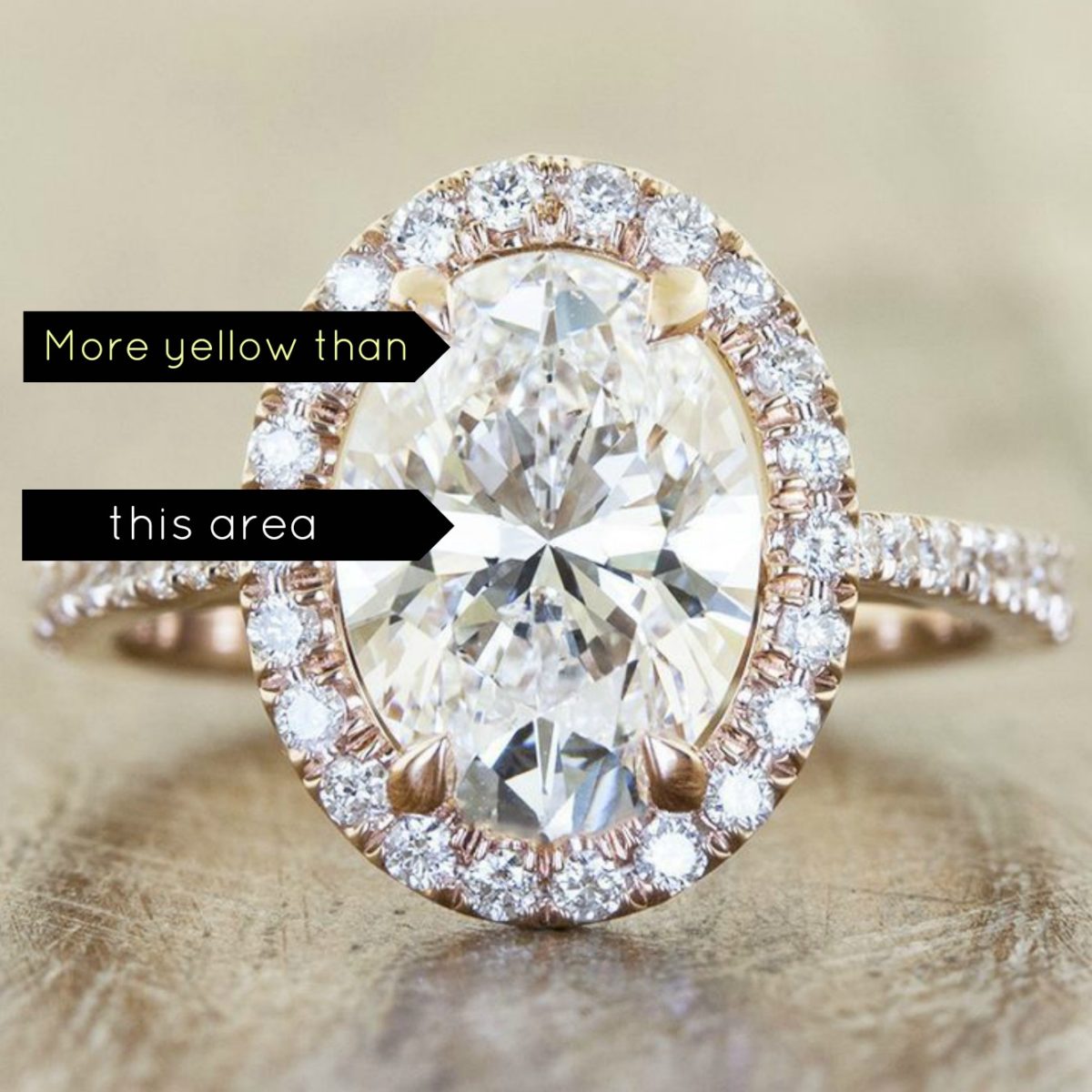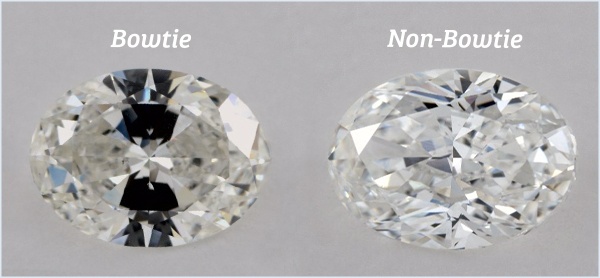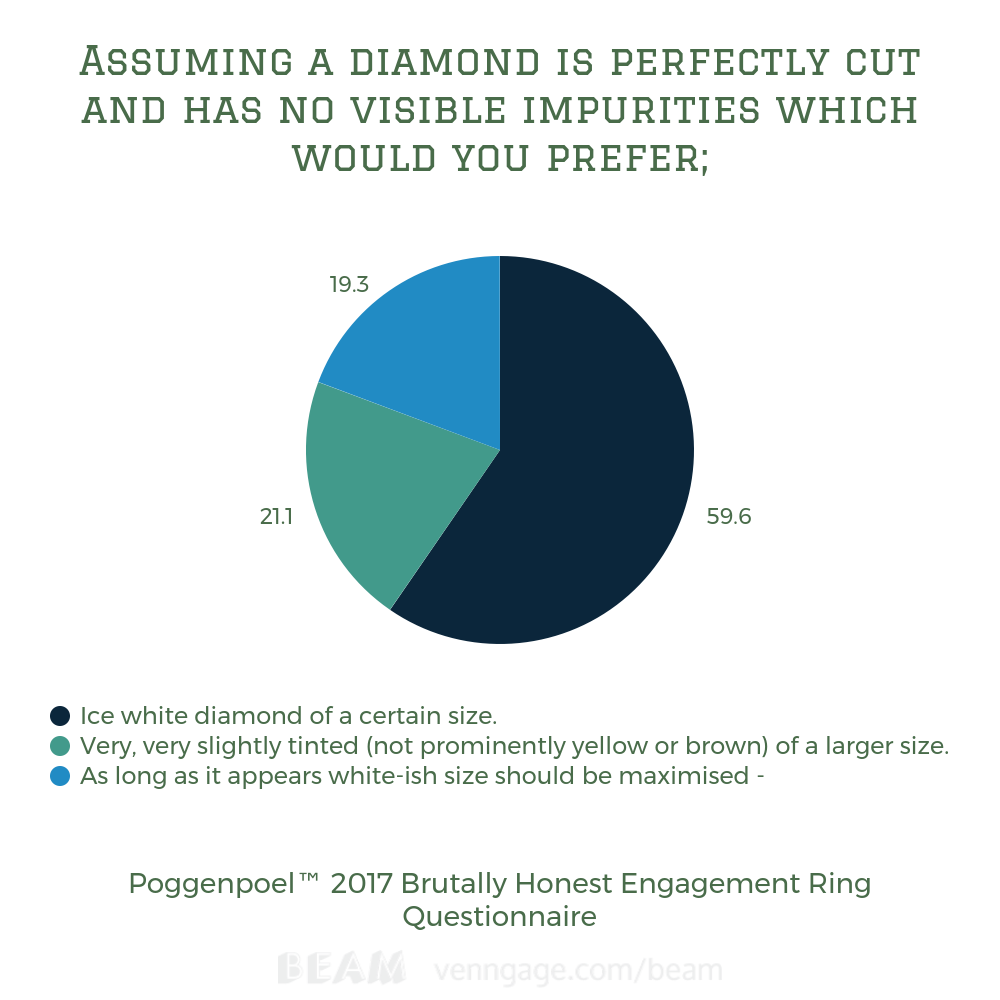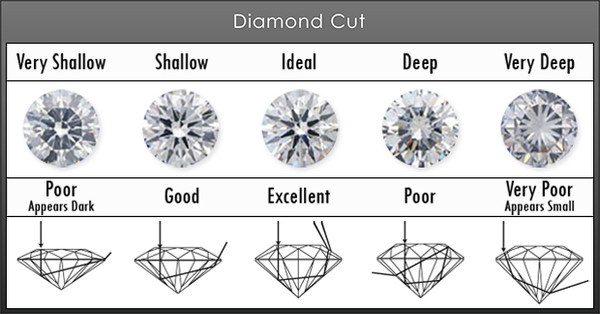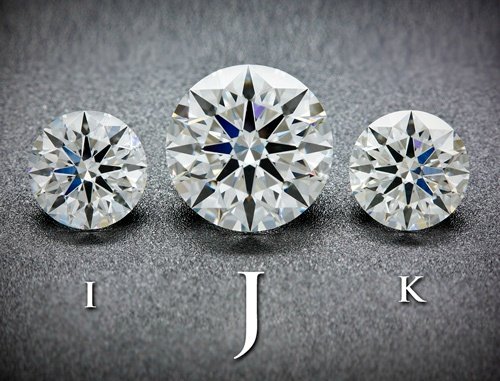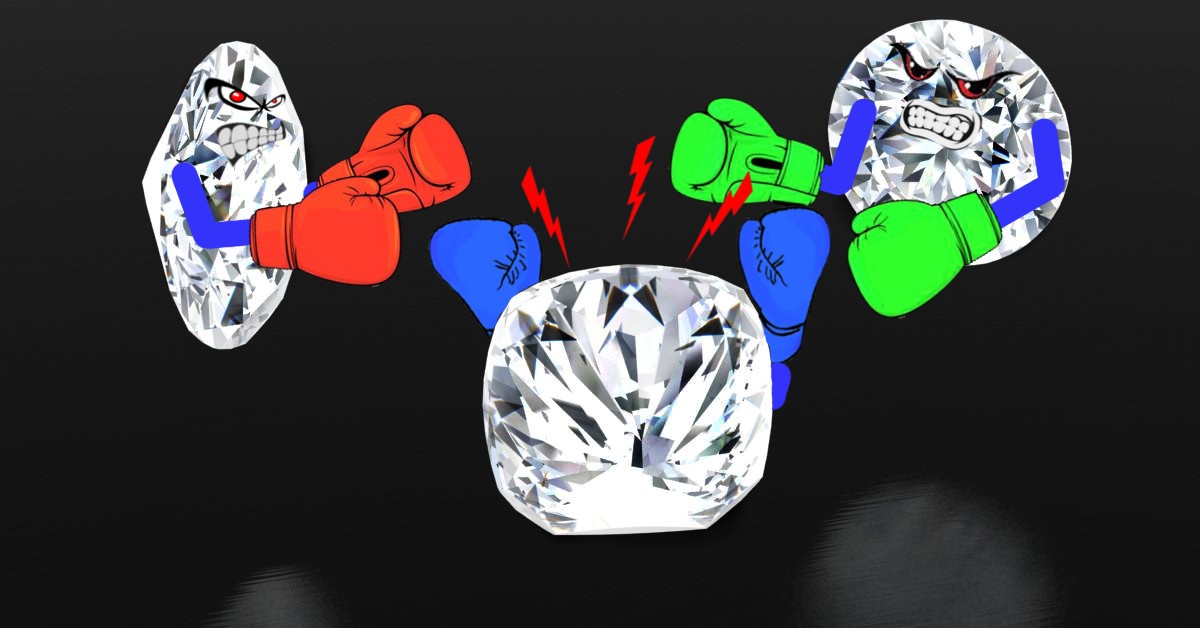
There’s no way around this; diamond size is a big deal.
Close to all engagement rings look considerably more visually pleasing when set with a larger diamond.
The internet, especially social media and Google Images search, has transformed the way couples approach the engagement ring browsing process.
These accessible technologies enable you to sift through millions of images, and cherry pick designs, or design themes, that all make up your perfect diamond engagement ring.
With over 70% of our work being custom designs; we’re emailed a ton of engagement ring photos every day.
Trends change, tastes differ but one constant remains; people prefer designs with larger (1,00ct+) diamonds as the centre showpiece.
If you’re not nodding, let’s do a quick experiment;
Hop onto the Pinterest page, desktop folder or wherever the preferred engagement ring designs are stashed. Most will have a description that include the size of the centre stone. If you can’t find this information try to do a search on the image to locate the source of the image – and read the fineprint running through the specifications of the diamonds and metal used. You’ll have an average centre stone size of over 1,00ct. Often 2,00ct or 3,00ct.
It’s not a vanity issue – the proportions of an engagement ring look better and better as you scale up the size of the diamond.
Let’s run through a common proportion issue;
The prongs that hold a centre diamond in place must be at least 0.90mm in diameter. If you move below that size you massively increase the risk that these prongs will bend and break through normal wear and tear.
Let’s set a 0,50ct diamond with 0,90mm prongs, and a 1,50ct diamond with the same minimum diameter 0,90mm prongs;
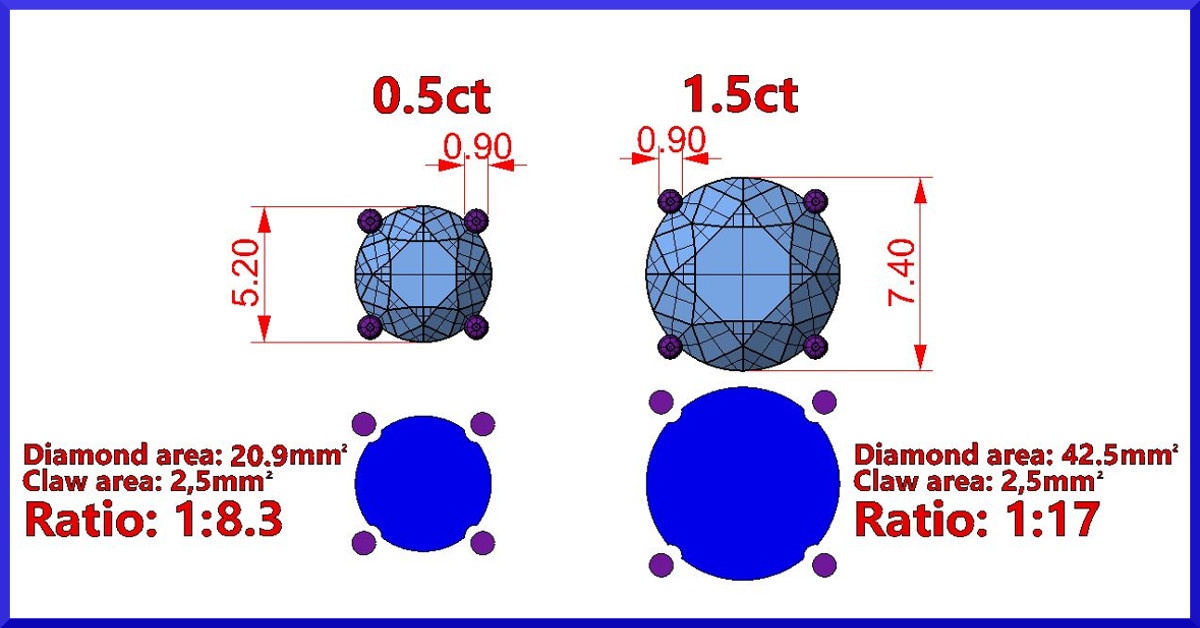
The prongs are way more pronounced on the smaller diamond. In terms of relative area to the centre stone the prongs on the 0,50ct diamond occupies double the area than on the 1,50ct example.
Let’s take a look at some shapes…
Whenever someone isn’t set on a certain shape we usually run through the 3 best alternatives; round brilliant, oval, and the beloved cushion.
We usually pin the size at around 1,00ct and show examples of each.
You’re probably not here so we plotted a 1,00ct cushion, oval, princess and round brilliant on our design platform, and measured the top view area that the diamond covers;
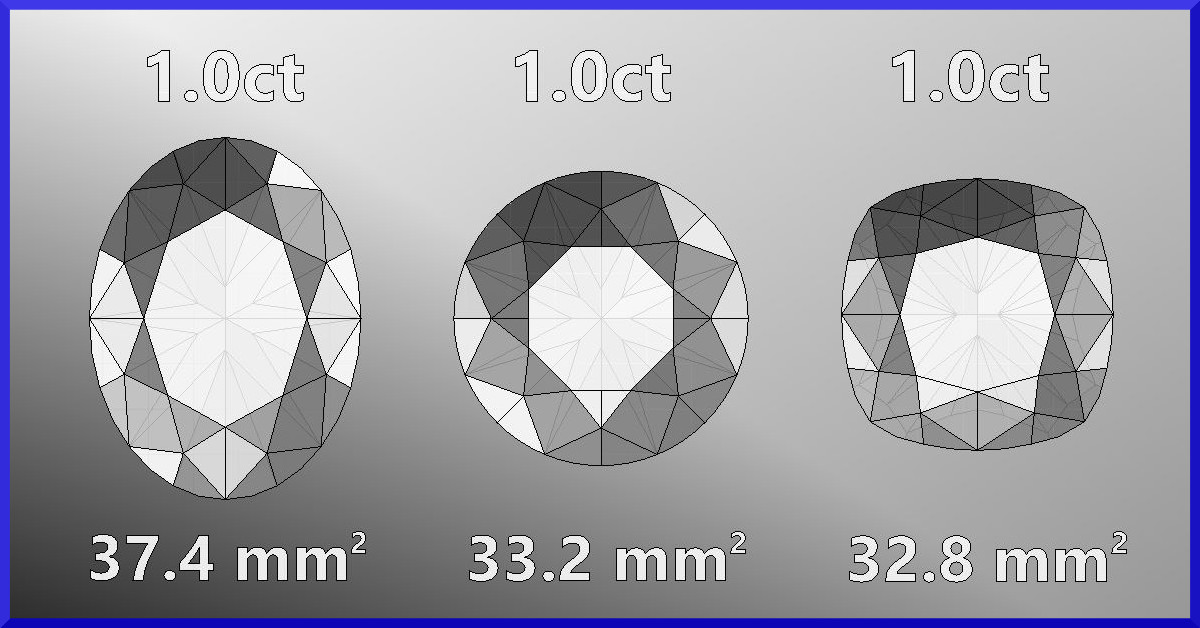
#1; 1,00ct Oval – 37,4mm2
#2; 1,00ct Round Brilliant – 33,2mm2
#3; 1,00ct Cushion – 32,8mm2
Wow. That’s a significant win for the oval.
Apart from area, the oval’s elongated shape further increases the perceived size.
So, if grandma is in distribution mode, pulls out her chest of diamonds and they’re all the same weight; grab the oval.
Pro Tip; Ovals are very colour sensitive and from “J” colour downwards you will see a slight tint of colour on its widest edges. Unfortunately an oval doesn’t display a uniform colour; and the contrast between the more coloured edges and the lighter center is very visible. J-K colours have nice vintage feel to them, and if you don’t mind the faintest amount of colour in your diamond they also make for great buys. If you’re looking for a white diamond consider “I” and better colours.
This picture clearly illustrates the more colour saturated edges;
Pro-Tip 2; 99% ovals have some degree of a bowtie effect. This bowtie can be anything from very hard to spot to a dark dull area in the middle part of the stone. Ensure you’re buying from a knowledgeable jeweller that knows the oval cut intricately. Most bargain bin ovals are in the bin mostly because of pronounced bowties.
*This is a worst case scenario bowtie, but it clearly shows the shape of a bowtie and where you’ll find it. Now that you know what to look for, revisit the image that illustrated the colour saturation differences – can you spot the bowtie?
Picking a diamond shape is a bit more complicated.
Let’s assume you don’t have a grandma with a drawer of 1,00ct on the dot diamonds in distribution mode.
Welcome to the club.
We have a very holistic approach where we optimise for diamond size, without visually compromising the overall appearance of a diamond.
In a recent survey, only 19% of women said the diamond size should be focused on and maximised within reasonable limits.
The other 81% want a diamond that’s completely free of visible inclusions and that appears white. They’ll gladly sacrifice a bit of size to have the rest in perfect harmony.
“Perfect harmony”?
Shape plays a massive part in the price and appearance of a diamond, but it’s excluded in the 4C model for 2 reasons;
- It doesn’t start with a C. Chape doesn’t make sense, you agree?
- Every shape has a unique way in which it works in this model. Different sweet-spots, different minimum specifications, unique challenges and benefits. The shape sets the stage for a 4C analysis.
Pro-Tip; If someone discusses the 4C framework without including and explaining the massive role of a diamond’s shape – the information is too watered down to be useful.
Let’s quickly run through the 4C model. If you need more detailed information head over to HERE. It’s a simple framework that explains the key characteristics of a diamond, and how these specifications affect the appearance and price of a diamond.
- Carat – The measure of diamond weight.
- Colour – Diamonds are found in a variety of colours, but the most common tones are brown and yellow. Alphabet letters are used to specify the colour of a diamond. Starting at “D” which is 100% colourless and as “white” as it gets all the way down to “Z” which will be prominently yellow or brown.
- Clarity – Diamonds are viewed at 10X magnification and then a grade is issued considering the amount, type, and severity of impurities in a diamond.
- Cut – Refers to how well a diamond has been cut and polish. This is the most important “C” and regardless of the carat, colour and clarity of a diamond, if it’s been poorly made you’re stuck with a dull piece of diamond that looks like glass. Stick to Excellent and Very Good cuts to ensure your diamond has optimal life, brilliance, and the x-factor (the sparkle issue everyone has a hard time verbalising).
Pro Tip; The “cut” does not refer to the shape in any way. I think a good 50% of jewellers get this wrong. What makes this confusion a pretty horrible flaw is the fact that cut is widely regarded as the most important “C”.
Quick recap; proper cut is non-negotiable, we’re optimising for size, but the diamond must still appear white and 100% free of any inclusions.
Don’t get too caught up in the terminology. When it comes to these 2C’s your eyes are as good as mine. We want a diamond that appears white (colour) , without any visible inclusions (clarity).
Minimum recommended colour and clarity specifications;
When you consider the top 3 shapes you have different parameters to stick to if you want that diamond to appear white;
- Round brilliant: Down to a “K” will still appear white. Medium and strong blue fluorescence will easily up the perceived colour by a grade or so.If you’re unfamiliar with fluorescence you can find more information here.
- Oval: I.
- Cushion I-J: Cushions also concentrate colour, but in a homogenous way. Since the colour is evenly distributed most couples find a “J” colour cushion white enough. You’ll have to come and take a look.
When we get to clarity it’s important to note that the bow-tie effect you’ll find on most ovals create a slightly duller (lacking brightness, vividness, or sheen) area in the diamond where inclusions are easier to spot. Out of the three shapes cushions hide imperfections the best since it’s without the doubt the most sparkly shape you’ll find. Life and brilliance in a diamond makes seeing imperfections much harder.
So, the oval has our highest minimum colour and clarity grade. As you move higher in the colour and clarity range the price of a diamond climes significantly.
Using the minimum values discussed, and then optimising for size (increasing the size of the diamond until you hit your budget ceiling) here’s what you can expect for R100 000 in each of the 3 shapes we discussed;
- Round Brilliant: 1,70ct K VS2
- Cushion: 1,90ct J VS2
- Oval: 1,40ct-1,50ct I VS1
*these are ballpark figures, but a true representation of the price differences at the time of publication. To see our latest recommended diamonds you can head over to; Diamond Specials.
Now let’s recheck the top view areas after the colour and clarity optimisation;
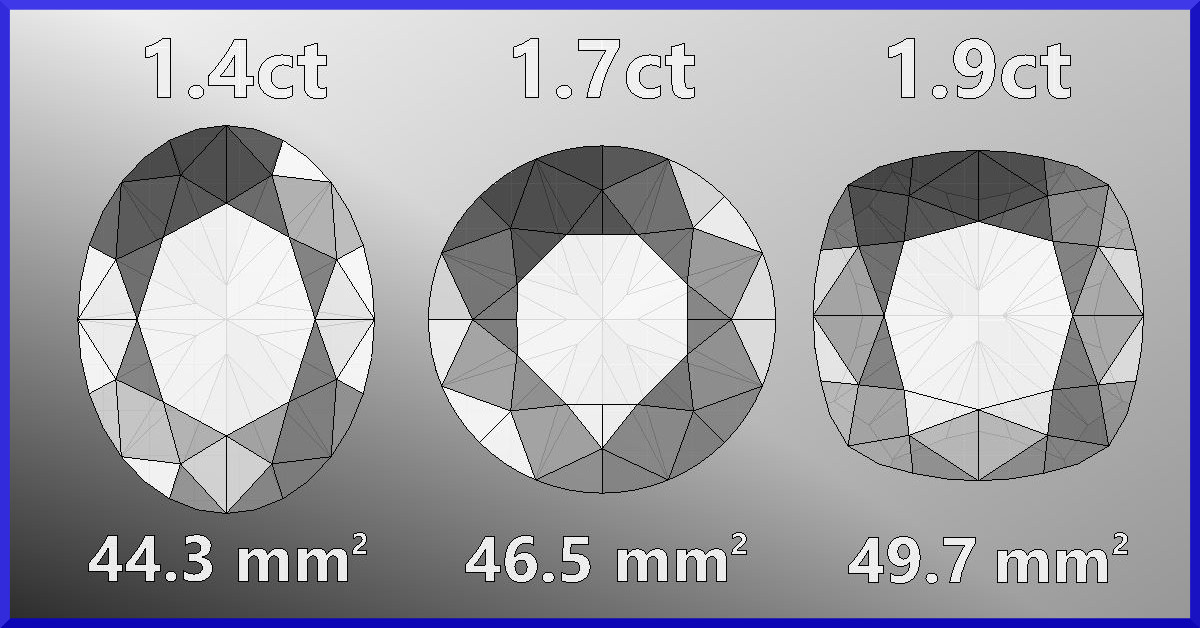
- Round Brilliant: 1,70ct K VS2 – 46,5mm2
- Cushion: 1,90ct J VS2 – 49,7mm2 #winning
- Oval: 1,40ct I VS1 – 44,3mm2
Although round brilliant cut is the most expensive shape, it makes up for this by being very lenient on the minimum colour specification.
Cushions are priced tremendously well. For a simple reason;
If uncle John buys a 2,00ct rough/unpolished diamond for R40 000 (he obviously has all the permits in place), he’ll have to pick which diamond shape he wants to cut the diamond into.
Using average yields he’ll end up in this range;
- 0,90ct Round Brilliant (43% recovery)
- 1,30ct Cushion Brilliant (65% recovery)
If he’s willing to sell the stone at say R50 000, the cushion will seem cheaper.
Because it is.
That’s it…
Which shape do we recommend?
The round brilliant has always been seen as the quintessential engagement ring diamond. It’s a very safe bet.
Ovals have a fanclub, and whoever is buying the stone should weight the recipient’s preference heavily. The bow-tie effect can be tricky and intimidating to understand and contextualize if you don’t know oval cut diamonds well. Obviously this issue is easily resolved by just working with someone who knows their diamonds. That’s us. I’m plugging like crazy today – but it’s all true.
Cushions are great buys. You get the most diamond for your money and their brilliance is unrivalled. If you’re not set on a specific shape I would recommend that you spend some time looking at cushion cuts. We love them.
Word of caution;
Since cushions close to always offer the highest yield they’re often polished to simply maximise the weight of a diamond. It’s a specialist cut and very few diamond polishers know how to execute the cut perfectly. If you’re out cushion shopping ensure that the jeweller is familiar with the cut and has a few at hand. If you ask for a cushion and he heads to the safe to take out that 1 “special cushion”… I seriously doubt that you’ll be viewing a masterfully cut diamond. That diamond has a story where someone ruthlessly pushed for weight.
Minimum diamond specifications are subjective, but the basics should be obvious. Everyone involved needs to know that a “J” colour seems white in a round brilliant, but will show colour in an oval. That and every detail we discussed above…
All these minimum specifications assume the GIA grading standards. If you’re considering other laboratories just note that most of them are considerably more lenient than the GIA. Lab B’s “K” colour might be significantly lower than that of the GIA. It’s important to understand that diamonds are priced according to their grading reports. If the diamond was over-graded you’re actually buying a lower quality diamond than you think.
Thank you for reading. We’d love to hear from you.
For any quotes and queries you can get in touch with us via; http://www.poggenpoel.com/contact-us/
Johan Poggenpoel
johan@poggenpoel.com

